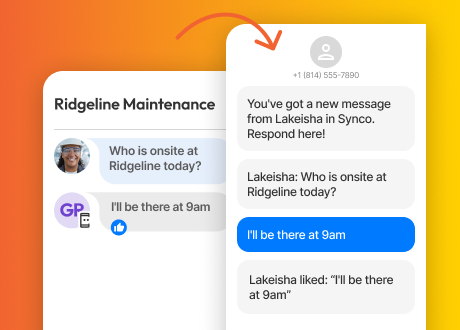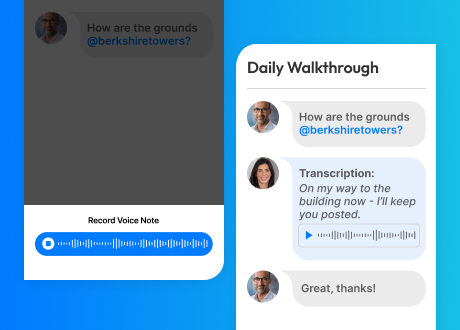To understand the impact of property management centralization on on-site staff members, we need to first look at what’s happening in property management today. Research shows that around 24% of property owners and managers struggle with understaffing problems in their maintenance operations, and almost half can’t retain and recruit staff.
On top of that, property owners and managers constantly battle unexpected maintenance and repairs, all while resident expectations continue to rise. Residents want friendly relationships with on-site staff, effective communication from management, and a clean and tidy community. Yet, with such high turnover rates in hard-to-staff positions, it’s clear that we need to focus not only on streamlining operations to improve the resident experience but also on empowering our on-site property teams.
Property management centralization strategies and technology can certainly help route resident requests correctly, and lessen the burden on these teams by weeding out duplicate requests, connecting them with centralized leasing, or giving residents tools to solve issues themselves – but there are still challenges in connecting the on-site and maintenance workflows to the corporate office.
In this post, we’ll explore why your boots-on-the-ground employees need the right tools, connectivity, and engagement with the corporate office to do their job well and stay motivated. Most importantly, we’ll share the best ways you can keep the personal touch in operations while in the midst of centralization.
Walking a Mile in Your Teams’ Shoes
Let’s talk about our on-site teams, who often are the “shock absorbers” of our operations because of their resident-facing roles. Regardless of the culture you’re creating in the corporate office, these team members are on the front lines, impacting resident experience and, consequently, revenue.
Your on-site staff are the first layer of defense when it comes to emergencies, property issues, or resident complaints. Even when you centralize shared functions like leasing or accounting, on-site team members still need to go back and forth with office staff about routine repairs, move-outs and move-ins, and vendor/contractor work onsite.
Being on-site at properties all day means these staff members need streamlined communication with all critical information in one place without requiring them to jump between multiple apps.
“Having strong connections between administrative staff who are in the office and on-site field personnel who are at our properties every day is critical. When someone on-site sees something as an emergency, our office team absolutely needs to respond to that immediately and get moving to solve it.”
Jeff Katz, VP of Field Operations at Milbrook Properties
Because centralization initiatives can reduce the size of the on-site team, we need to understand how those still at the site-level carry out their day-to-day. To enable better communication with your on-site staff (and retain that personal touch) take stock of the following:
- What tech equipment do your on-site team members have? Do they use personal or company cell phones, or tablets for communication?
- Does every individual at your company have a dedicated email address, or are there pooled emails for properties (propertymanager123mainstreet@acmemanagement.com)?
- What are the capabilities of the devices they use? Are they able to check email and receive phone calls on their phones? And what about texts? You’ll inevitably face a communication breakdown if you rely on email but the maintenance staff doesn’t.
- How do issues get escalated to leadership from the site level? When someone who is normally on-site goes on vacation or is unexpectedly out of the office, how quickly and efficiently can you step in to avoid disruption?
The Role of Communication in Empowerment
As we mentioned before, resident expectations are higher than ever. Yet, a HappyCo survey found that only one in 12 residents reported a positive experience with maintenance.
As on-site teams have shrunk due to centralization, remaining on-site staff members may feel isolated, and disengaged from corporate conversations and initiatives.
A huge component of on-site staff providing an exceptional experience is keeping them in the loop so they can do their jobs well. Research shows that companies with a highly engaged workforce have higher profitability and productivity than companies with a disengaged workforce.
In other words, our boots-on-the-ground staff need to feel connected and part of the team. They also need to feel that they have what they need to perform, which is why the best thing we can do to empower our on-site teams is to give them the tools they need to do their jobs well.
Emergency Scenarios
Our on-site squad is on the frontline during emergencies, needing quick help from the office team for tasks like getting vendors paid for any cleanup work and keeping residents informed of what’s going on.
When emergencies strike, an empowered on-site team means a faster response. With centralization reducing staff, make sure your on-site crew has what they need to respond to emergencies quickly and effectively.
- Pre-approved vendor lists. Does your on-site manager have a contact list for immediate emergencies like water damage or fire cleanup? Or do they need corporate office approval to bring in vendors?
- Repair proposals and approvals. What’s the spending threshold for when higher sign-off is required? Clear authority limits let the on-site staff handle routine fixes.
- Resident communications. Who posts lobby updates during disruptions? Digital alerts? Print signage? On-site teams need to know the process here so they can provide accurate, timely notices.
Without streamlined processes, delays or confusion around approvals can slow response times when every minute matters.
Clarify exactly what your on-site staff can handle without waiting for the go-ahead. Empower them to deliver quick fixes and updates when the unexpected happens.
Recordkeeping Challenges
On-site staff are responsible for collecting the photos and “proof” we rely on to make costly decisions – think security deposit inspections, photos of any damages, or photos that provide proof that a service provider has completed a job.
If there’s no organized system for these records (photos, videos, inspection documents) to get stored at the office level, there’s bound to be frustration on the part of your on-site team. They will be asked over and over again for the same images or files, and need to dig through their phones or emails.
Onsite staff need a quick and easy way to take and file this documentation down to the unit level, so it can easily be found later by the corporate team should they need it down the line (let’s say, for verifying a security deposit payout, verifying an invoice should be paid, or sending to an insurance company).
Breaking Down Communication Silos
In our industry, communication is considered “the central nervous system.” Ensuring that all parts of the organization can work together smoothly is crucial. When communication is ineffective, it leads to bad decisions, especially in a centralized structure where site-level staff have big responsibilities.
Real-time communication tools provide major benefits to your organization:
- You will boost your property management centralization efforts by providing easier ways to communicate for all team members and connecting information throughout your property management tech stack.
- Real-time messaging helps foster human connections, adding a personal touch beyond formal emails. Plus, emojis, reactions, and real-time feedback bring out the emotional side of communication, which contributes to a positive work culture.
“Before Synco, we were using email and texting, and many of our field personnel were using WhatsApp as well. It was hard to figure out where information was located – where was that photo? Did I lose that photo? Who sent that photo over which channel? Trying to take videos or photos off of an app and upload them onto email – so much got lost in translation, and we were spending more time searching and re-uploading than actually solving problems.”
Jeff Katz, VP of Field Operations at Milbrook Properties
Preserving the Human Touch in a Centralized World
In the world of property management, where success relies on smooth operations and happy residents, we all recognize the crucial role of on-site staff. As we navigate the era of property management centralization, we must not overlook our on-site heroes who hold everything together.
By embracing real-time communication solutions, you connect your teams and strengthen the foundation of your property management operations.
See how Synco empowers on-site staff and elevates your organization



